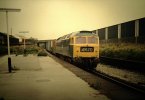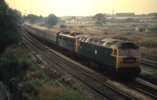"The driver of tank wagon train 6F52, before departing from Folly Lane, Runcorn, was informed that the train was fully braked and thus drove up to the maximum permitted speed for a train of this type of 60 mile/h. When descending the 3¼ mile falling gradients on the line approaching Weaver Junction the train ran out of control due to only eight of the wagons being fitted with vacuum brakes instead of the whole train being so fitted as the driver had been led to suppose. The train ran past Signal WJ 11, protecting the Junction, at Danger and struck the side of Freightliner train 4068 at the Junction.
The Up Liverpool and Up Warrington lines run approximately parallel to each other for a distance of approximately one mile before the Junction and the driver of the Freightliner train, which was travelling at about 70 mile/h under clear signals, saw sparks being emitted by the brake blocks on a number of wagons on 6F52 on the Liverpool line. As it appeared to him that the train would over-run the Junction, he gave his locomotive more power in an effort to clear the junction before the other train reached it and thus avert a collision. His efforts unfortunately were not successful, but at least a collision between the two locomotives was avoided.
The electric locomotive and leading four Freightliner vehicles of train 4068 were not derailed. The trailing bogie of the fifth vehicle was derailed, the roller bearing assembly was damaged, as were two of the clamping brackets; one brake and wheel was broken. Thereafter all the ten vehicles were derailed, the wheels and bogies suffering extensive damage."




